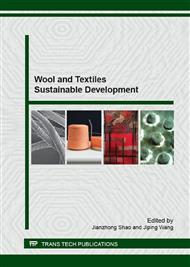[1]
Xue B, Gao L, Hou Y, et al. Temperature controlled water/oil wettability of a surface fabricated by a block copolymer: application as a dual water/oil on–off switch. Adv Mater. 25 (2013) 273-277.
DOI: 10.1002/adma.201202799
Google Scholar
[2]
Yu Q, Zhang Y, Chen H, et al. Protein adsorption and cell adhesion/detachment behavior on dual-responsive silicon surfaces modified with poly (N-isopropylacrylamide)-block-polystyrene copolymer. Langmuir. 26(2010) 8582-8588.
DOI: 10.1021/la904663m
Google Scholar
[3]
Liu X, Ye Q, Yu B, et al. Switching water droplet adhesion using responsive polymer brushes. Langmuir. 26 (2010) 12377-12382.
DOI: 10.1021/la101909e
Google Scholar
[4]
Fürstner R, Barthlott W, Neinhuis C, et al. Wetting and self-cleaning properties of artificial superhydrophobic surfaces. Langmuir. 21 (2005) 956-961.
DOI: 10.1021/la0401011
Google Scholar
[5]
Xin B, Hao J. Reversibly switchable wettability. Chem Soc Rev. 39(2010) 769-782.
DOI: 10.1039/b913622c
Google Scholar
[6]
Tsitsilianis C. Responsive reversible hydrogels from associative smart, macromolecules. Soft Matter. 6 (2010) 2372-2388.
DOI: 10.1039/b923947b
Google Scholar
[7]
Lee H, Pietrasik J, Sheiko S S, et al. Stimuli-responsive molecular brushes. Prog Polym Sci. 35 (2010) 24-44.
Google Scholar
[8]
Crespy D, Rossi R M. Temperature‐responsive polymers with LCST in the physiological range and their applications in textiles. Polym Int. 56 (2007) 1461-1468.
DOI: 10.1002/pi.2277
Google Scholar
[9]
Yim H, Kent M S, Mendez S, et al. Temperature-dependent conformational change of PNIPAM grafted chains at high surface density in water. Macromolecules. 37 (2004) 1994-(1997).
DOI: 10.1021/ma0354290
Google Scholar
[10]
Lavrič P K, Tomšič B, Simončič B, et al. Functionalization of cotton with poly-NIPAAm/chitosan microgel: Part II. Stimuli-responsive liquid management properties. Cellulose. 19 (2012) 273-287.
DOI: 10.1007/s10570-011-9635-7
Google Scholar
[11]
Kato K, Uchida E, Kang E T, et al. Polymer surface with graft chains. Prog Polym Sci. 28 (2003) 209-259.
Google Scholar
[12]
Yang H, Esteves A, Zhu H, et al. < i> In-situ</i> study of the structure and dynamics of thermo-responsive PNIPAAm grafted on a cotton fabric. Polymer. 53(2012) 3577-3586.
DOI: 10.1016/j.polymer.2012.05.053
Google Scholar
[13]
Xing T, Liu J, Li S. Surface-initiated atom transfer radical polymerization on cotton fabric in water aqueous. Text Res J. (2012): 0040517512461684.
DOI: 10.1177/0040517512461684
Google Scholar
[14]
Sun D, Stylios G K. Investigating the plasma modification of natural fiber fabrics-the effect on fabric surface and mechanical properties. Text Res J. 75(2005)639-644.
DOI: 10.1177/0040517505057637
Google Scholar
[15]
Wang H, Fang J, Cheng T, et al. One-step coating of fluoro-containing silica nanoparticles for universal generation of surface superhydrophobicity. Chem Commun. (2008)877-879.
DOI: 10.1039/b714352d
Google Scholar
[16]
YANG H, ESTEVES A, ZHU H, et al. In-situ study of the structure and dynamics of thermo-responsive PNIPAAm grafted on a cotton fabric. Polymer. 53(2012)3577-3586.
DOI: 10.1016/j.polymer.2012.05.053
Google Scholar
[17]
Jiang C, Wang Q, Wang T. Tunable wettability via counterion exchange of polyelectrolyte brushes grafted on cotton fabric. New J Chem. 36(2012) 1641-1645.
DOI: 10.1039/c2nj40246g
Google Scholar
[18]
Xia F, Feng L, Wang S, et al. Dual‐Responsive Surfaces That Switch between Superhydrophilicity and Superhydrophobicity. Adv Mater. 18(2006): 432-436.
DOI: 10.1002/adma.200501772
Google Scholar


